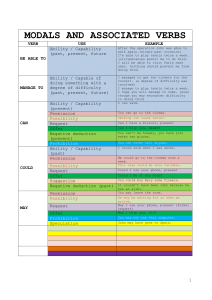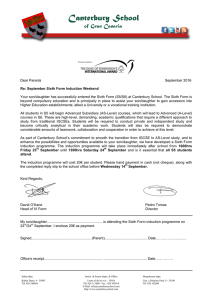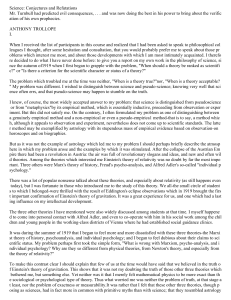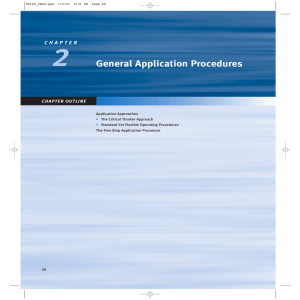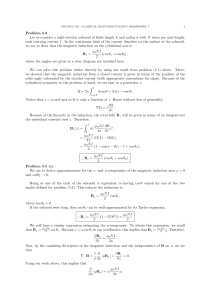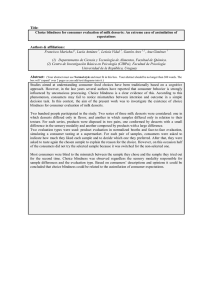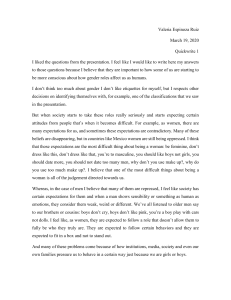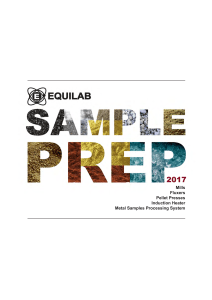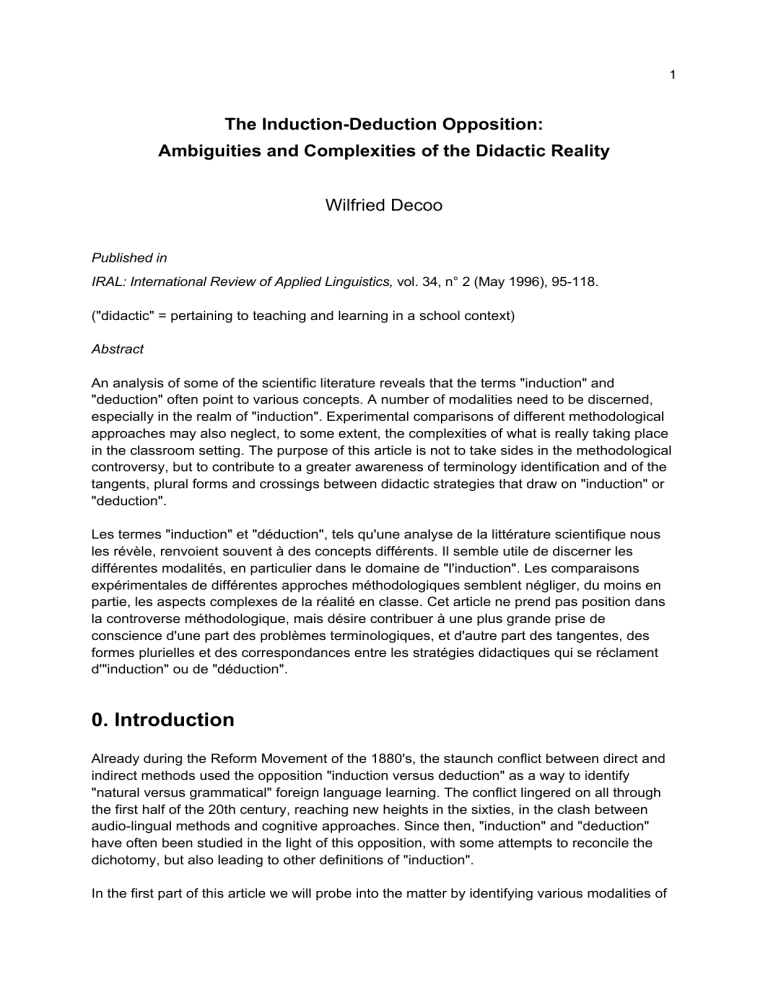
1 The Induction-Deduction Opposition: Ambiguities and Complexities of the Didactic Reality Wilfried Decoo Published in IRAL: International Review of Applied Linguistics, vol. 34, n° 2 (May 1996), 95-118. ("didactic" = pertaining to teaching and learning in a school context) Abstract An analysis of some of the scientific literature reveals that the terms "induction" and "deduction" often point to various concepts. A number of modalities need to be discerned, especially in the realm of "induction". Experimental comparisons of different methodological approaches may also neglect, to some extent, the complexities of what is really taking place in the classroom setting. The purpose of this article is not to take sides in the methodological controversy, but to contribute to a greater awareness of terminology identification and of the tangents, plural forms and crossings between didactic strategies that draw on "induction" or "deduction". Les termes "induction" et "déduction", tels qu'une analyse de la littérature scientifique nous les révèle, renvoient souvent à des concepts différents. Il semble utile de discerner les différentes modalités, en particulier dans le domaine de "l'induction". Les comparaisons expérimentales de différentes approches méthodologiques semblent négliger, du moins en partie, les aspects complexes de la réalité en classe. Cet article ne prend pas position dans la controverse méthodologique, mais désire contribuer à une plus grande prise de conscience d'une part des problèmes terminologiques, et d'autre part des tangentes, des formes plurielles et des correspondances entre les stratégies didactiques qui se réclament d'"induction" ou de "déduction". 0. Introduction Already during the Reform Movement of the 1880's, the staunch conflict between direct and indirect methods used the opposition "induction versus deduction" as a way to identify "natural versus grammatical" foreign language learning. The conflict lingered on all through the first half of the 20th century, reaching new heights in the sixties, in the clash between audio-lingual methods and cognitive approaches. Since then, "induction" and "deduction" have often been studied in the light of this opposition, with some attempts to reconcile the dichotomy, but also leading to other definitions of "induction". In the first part of this article we will probe into the matter by identifying various modalities of 2 induction and deduction in a more theoretical educational framework. An overview of some of the literature on the subject will then allow us to see how these modalities fit in the views of a number of authors. In the second part we will move into the didactic reality of the teacher and the learner, to identify some of the ambiguities of the theoretical framework and to draw possible didactic conclusions. 1. Induction and deduction in a more theoretical educational framework 1.1. The traditional dichotomy Deduction is understood as the process that goes from the general to the specific, from consciously formulated rules to the application in language use. It evokes the image of the grammar-based methods and of cognitive approaches. In contemporary terminology it is easily identified with learning. Induction is the process that goes from the specific to the general, namely first the real language use, from which will "emerge" patterns and generalizations. It evokes natural language learning and a variety of direct methods. In contemporary terminology it is easily identified with acquisition. 1.2. Refinement into five modalities The traditional dichotomy, however, is not sufficient to identify a number of obvious modalities of induction and deduction in the educational process. The following five brands can easily be identified - but each of them could be further refined in complex and dynamic subcategories, while some other combinations could be added: Modality A - Actual deduction Modality B - Conscious induction as guided discovery Modality C - Induction leading to an explicit "summary of behaviour" Modality D - Subconscious induction on structured material Modality E - Subconscious induction on unstructured material Modality A - Actual deduction The grammatical rule or pattern is explicitly stated at the beginning of the learning process and the students move into the application of this grammar (examples and exercises). 3 Modality B - Conscious induction as guided discovery The students first encounter various examples, often sentences, sometimes embedded in a text. The "conscious discovery" of the grammar is then directed by the teacher: on the basis of the examples he normally asks a few key-questions and the students are led to discover and formulate the rule. The rationale usually given is that students who discover the rule on their own will profit from this. Modality C - Induction leading to an explicit "summary of behaviour" Here we take a first step into a more behaviouristic tradition. The learner first practises a certain structure in an intense way. Through this practice the rule is "somehow" induced and internalized. Then, at the end of the learning segment, the teacher summarizes the rule explicitly. The methodologists advocating this approach avoid the impression that this explanation is important, by simply calling it "a summary of behaviour". It was the approach of early proponents of audio-lingualism and can be detected in a number of specific methodological recommendations of the past three decades. Modality D - "Subconscious" induction on structured material "Subconscious" is put between quotations marks because the concept of consciousness or not is often considered a slippery notion (Odlin, 1986; Schmidt, 1990). Subconscious induction is understood here as the learning process that will not make use of explicitly formulated grammar. Abstractions and generalizations are left to the "subconscious capabilities" of the students. In subconscious induction on structured material, the students are exposed to language material that has been structured in such a way to help the inductive process. The principle advocates that through the systematic repetition of the same pattern, through graded variations, through drill and practice, the student will come to an "integrated mastery" of the rule, without conscious analysis. This modality was the major technique advocated by many of the audio-lingual methods around 1960, and especially by the French audio-visual methods. Modality E - "Subconscious" induction on unstructured material This is supposed to come as close as possible to "natural acquisition". Only intense language practice is given, on the basis of authentic input, without any linguistic structuring or manipulation. "Generalizations" will come naturally, comparable to first language acquisition. 1.3. An overview of some of the literature The distinction between those five modalities will help us to better identify the analysis of a 4 number of authors. Indeed, especially the term "induction" is sometimes used indiscriminately for rather divergent processes, namely modalities B, C, D or E. To help avoid confusion in our treatment of the subject, we will always clarify our identification of the terms by referring to the modalities. In the second half of the sixties, when the cognitive reaction hit the audio-methods, the clash was clear-cut: behaviouristic habit-formation was opposed to controlled mental processes. To our students we like to explain this clash as the Waterloo of language teaching methodology: the issues were black and white, the opponents well-defined, the battle fascinating. Among the many opposing flags, the one with "induction" written on it was waved against the one with "deduction". But Wilga Rivers, who was identified with the cognitive camp, uses the terms deduction and induction to discern between modalities A and B, not to oppose "conscious" versus "subconscious". Induction thus happens when a student "evolves a rule" from the given examples "with the help of his teacher" (Rivers, 1975:105; see also Rivers, 1972:81-83). In a more detailed discussion of this process, Rivers recommends the use of an age-criterium to select between the two approaches: the deductive approach (modality A) is most useful for mature, well-motivated students, or for adult student in intensive courses, while the inductive approach (modality B) is more appropriate for young language learners (1975:248). Rivers does not, however, specify what age "young" learners have in her opinion. Since "induction" for her still means coming to an understanding of explicit grammar, we may presume she has somewhat older children in mind, capable of cognitive insight, e.g. age 10 and older. The age factor is clearly defined in an experiment by Ingvar Werdelin (1968) who studied "induction" versus "deduction" in the learning of a foreign language alphabet with sample groups of sixth and eight grade pupils. Sensitiveness to the definition problem is shown in the distinction Werdelin makes between "instruction in principle before application to examples" (modality A) and "examples followed by principle clarification and supplemented by further examples" (modality B), although the term "principle clarification" would need clarification itself. The third method used in the experiment was "examples only" (modality C or D?). One should also notice that the research dealt with the learning of a foreign alphabet, not really of grammatical rules. William Littlewood (1975) is also an author who makes distinctions between the various modalities, while at the same time recognizing that "they are not exclusive and may function together in varying proportions". He uses the terms "to induce", "inductions", and "inductive strategy" for modalities C, D and E, clearly discerning between each of them. Littlewood then considers two sub-strategies for the approach that makes the grammar explicit: - The first is when the rule "is regarded as a summary of behaviour, coming after the presentation of a piece of language, perhaps also after it has been practised for a time". This seems to pertain to modality C, but the factor "time" is not clarified. A short time of a few minutes would bring us closer to modality B. - The second sub-strategy is clearly modality A, when "command of the rule through explanation is regarded as the starting-point for language use". Littlewood calls this "an overall deductive strategy", but adds: "it does not exclude using inductive classroom techniques", no doubt referring to modality B. 5 As we will see later in our discussion, Littlewood is perfectly justified in closely identifying modality B with both modality A and modality C. Littlewood's article itself, in defence of explicit and functional grammar-teaching, hails "overt" grammar teaching (using both deduction and conscious induction) as opposed to "inductive processes", which then clearly mean modalities D or E of subconscious induction. Herbert Seliger (1975) summarizes his doctoral dissertation devoted to a comparison of what he called "an inductive method with a modified deductive method". An inductive method, according to Seliger, is one where the learner "has discovered the underlying abstraction for himself". In the description of his experiment, Seliger clarifies that the students working with the inductive method first practise a certain structure (which lends itself "to clear and concise verbalization as a language rule"), and that the grammatical explanation would follow each lesson segment as a "summary of behaviour". Seliger thus understands this "inductive method" basically as modality C. However, some ambiguity remains in Seliger's occasional use of the term "induction" for processes that belong to the natural, subconscious acquisition (modality E), for example when he mentions the assumptions "that the child learns not by rules but by imitation and induction" (p. 3). The same terminological uncertainty remains in Seliger's critical description of "induction versus deduction in audio-lingual method", whereby it is not always clear whether modalities C, D, or E are meant. By the same token, however, Seliger's thorough analysis shows that many proponents of a non-deductive approach struggled with these very incongruities, because of insufficient distinction between various forms of language integration: from the most behaviouristic habit-formation, to some vague problem-solving procedures, to stronger generalizations, and finally to real awareness of rules. In an article specifically devoted to the "Deduction/induction controversy", Hector Hammerly first draws a mini-history of deduction and induction through the centuries, using "deduction" for modality A, and "induction" for modalities D and E, without distinction (Hammerly, 1975). Hammerly calls the traditional dichotomy "an unnecessarily polarizing distinction" and claims to have found an easy reconciliation, namely "audiolingual habit formation with deduction and cognition". His methodology then starts from explicit grammar through modality A or B, both of which Hammerly puts under the heading "deduction". This "cognition" is then to be followed by intense application, so that "the rule can be gradually phased out from the students' attention". In the rest of his article, Hammerly presents another way to combine both deduction and induction: "Certain structures are most amenable to a deductive approach while others -many others -- can be learned very well by an inductive approach". But a clear distinction between modalities C and D is not made: a certain Spanish structure "can be learned inductively by just about any class in a few minutes, given the right exercises". Here the "inductive" way, firstly understood as "subconscious", seems to become more modality C, leading to explicit grammar. Indeed, Hammerly concludes for this "inductive" approach, that it "allows the learners to 'discover' by themselves how a part of the language works. This makes the learning process more interesting and, according to psychologists, such 'learning by discovery' is better retained." 6 Hammerly tackles the subject again in his Synthesis in second language teaching (1982:410-417). Deduction and induction are still seen in the traditional dichotomy: deduction is modality A, namely "from a rule statement to the application"; induction is modality D and E, without distinction, namely going "from examples to a generalization". Hammerly clarifies: "This generalization, however, is usually left unstated, so that the rule is supposed to be learned through practice, without analysis." He then identifies modality B, conscious induction, and calls this appropriately "guided discovery". He devices a chart "for the determination of teaching procedure for individual rules", based on the similarity and dissimilarity with the native language and with the degree of difficulty. Hammerly claims that the dissimilar and more difficult items (about 20 %) need to be explained through deduction, the similar and easy items (about 20 to 30 %) through induction (meaning subconscious induction), the medium items (50 to 60 %) through guided discovery. Hammerly does not mention how he calculated these percentages and to what languages they apply. Robert Fischer, in his article "The inductive-deductive controversy revisited" (1979) clearly defines "deduction" as modality A, and "induction" as modality B. His description of induction leaves no doubt as to this point of view: the student "discovers the grammatical principle", and "his linguistic competence will guide him, in effect, in analysing the foreign language data and formulating the appropriate rule". The only somewhat confusing terminological identification comes in Fischer's statement that "historically, the inductive approach has been associated with the audio-lingual method". This would refer to either modalities C or D, but Fischer does not go into this distinction. Like Hammerly, Fischer believes that both deduction and induction, as he views them respectively as modality A and modality B, have their place in the learning process. He also tries to determine criteria to select the one or the other approach. For him, contrastive analysis provides these criteria, in relation to a theory of learning transfer: if the foreign language grammar rule is similar or dissimilar but simpler than the native language rule, then an inductive approach is the most appropriate; if the foreign language grammar rule is dissimilar and of equal or greater complexity than the native language rule, a deductive approach is to be preferred. Dulay, Burt and Krashen (1982) use the term "deduction" for modality A, and "induction" for modality B: for them "induction" is conscious induction, namely "when practice precedes the explanation, and when its goal is to help the student discover the form of the rule" (p. 17). One can easily see the possible confusion arising from a superficial reading of Krashen's publications, because his famous contrasting "learning" to "acquisition" does not match the traditional dichotomy between "deduction" and "induction", where the latter pertains to subconscious induction. Dulay, Burt and Krashen consider both deduction and induction as part of conscious learning and they oppose both of them to acquisition. Therefore, both deduction and induction are seen as part of "a conscious exercise in grammatical form" (p. 18). In the same vein, the three authors criticize "inductive ability" as one of the aptitudes to predict communicative competence: inductive ability, for them, is only good to predict "who will attain a high degree of metalinguistic skill awareness" (p. 69). The functional-notional approach, as described by Finocchiaro and Brumfit (1983), encourages to learn grammatical structures using a combination of modalities B and C. It means that a new structure is first presented and repeated several times into a variety of sentences, then studied under the guidance of the teacher so that the students "discover the sounds, the written form, the position in the sentence, and the grammatical function of the 7 new structure" (p. 122). The authors do not use the terms "deduction" or "induction" in this description. But the index refers to these pages under the heading "inductive process", implying that to the authors induction means modalities B and C. We should also, at this point, refer to the critical study of Terence Odlin (1986) who deals with the definition and nature of explicit versus implicit knowledge. Although the aim of Odlin's article is not to analyze the dynamic ways in which explicit knowledge is achieved, she provides definitions and clarifications of explicit versus implicit knowledge as given entities with peculiar tangents, viewed against some of the ideas of Krashen and of Bialystok. Odlin thus contributes to a better understanding of the various forms of explicit knowledge, which, of course, must have been achieved through various form of deduction and induction. In his overview of experiments dealing with formal language instruction, Craig Chaudron (1988) points at the large number of product-studies that have investigated the effects of explicit versus implicit grammar instruction on achievement. Chaudron calls the implicit approach "pattern practice or inductive" (modalities C or D). However, he himself adds the critical remark that in a number of these experiments "classroom process variables have typically not been observed closely or manipulated (thereby leaving some doubt as to the true differentials in instructional treatments)" (p. 166). Chaudron therefore recommends more narrowly focused research on particular instructional variables. Constance Shaffer (1989) studies a comparison of inductive and deductive approaches, and is very sensitive to the differences. According to Shaffer, an inductive approach was formerly always equated with the audio-lingual method of the sixties, defined as habit-formation (modality D or E), unless the teacher gave the students at the end of the lesson the appropriate rule (modality C). For the purpose of her study, Shaffer clearly defines an inductive approach as modality B: "The students' attention is focused on the structure being learned... and the students are required to formulate for themselves and then verbalize the underlying pattern" (p. 396). Shaffer's pilot study further indicates that also weaker students benefit from this inductive approach. In a similar pilot study of the same year, Virginia M. Scott (1989) addresses a comparison of explicit and implicit teaching strategies. In this study, the explicit strategy is clearly modality A, actual deduction (explicit presentation of a grammar rule, followed by a few examples) and the implicit strategy is modality D, subconscious induction on structured material (the students listen repeatedly to the material embedded naturally in a text; the text is "heavily weighted" with the structures to be learned; no explicitation follows). The conclusion of the study is "the superior performance of students exposed to explicit grammar" (p. 19). In a follow-up study, however, Scott (1990) defines the explicit strategy as the "deliberate study of a grammar rule, either by deductive analysis or inductive analogy". Here "inductive", in its connection with "deliberate study" refers to modality B. The description of the experiment does not, however, clarify the procedural differences between this "deductive analysis" and this "inductive analogy". Julia Herschensohn (1990) defends an effective role for explicit grammar in communicative methodologies. She clarifies her position by stating that a "teacher's focus on grammatical structure does not require a return to grammar-translation (deductive presentation) or audiolingual (inductive rote presentation) methodology". "Deductive presentation" is certainly 8 to be understood as modality A, "inductive rote presentation" most probably as modality C or D. In her defence of a grammar presentation and practice that can be adapted to current communicative methodologies, Herschensohn refers to Shaffer's "inductive approach" (see above), i.e. modality B, which she further identifies as an "interactive, participatory mode. In this manner of explanation the teacher presents grammar points inductively, using realia and visuals which involve students directly". It must lead to a consciously articulated "knowledge of language", imparted in a direct and interactive way. In her study on the role of grammar instruction in a communicative approach, Tracy David Terrell uses the term "explicit grammar instruction", coined EGI, "somewhat loosely to mean the use of instructional strategies to draw the students' attention to or focus on form and/or structure" (Terrell, 1991, p. 53). The various techniques mentioned include explicitly pointing out a phenomenon, giving a special sort of input with many examples, doing focused exercises. Terell is manifestly aware of the variety and overlapping nature of brands of EGI, although an analysis of their differences is not the purpose of her study. Carol Herron and Michael Tomasello (1992) contrast the deductive approach (clearly identified as modality A) with "guided induction", in which the learner takes an active role in hypothesis testing on the basis of clear cut examples, but at no time does either teacher or student explicitly state the rule. Basically this "guided induction" can be understood as modality D, because explicit analysis is to be avoided at any time. On the other hand, the obvious clarity of model sentence and drill practice, as described in the experiment by Herron and Tomasello, is undoubtedly meant to elicit learner strategies, even if not externalized, belonging to modality C or even B. Richard Donato and Bonnie Adair-Hauck (1992) criticize the simple dichotomy between deductive and inductive approaches, as if the former only entails explicit explanations by the teacher (modality A) and the latter only implicit learning by the student (modalities D and/or E). They draw the attention to the difference between monologic instruction (modality A) and proleptic instruction, where the dialogue between teacher and learner provides for "guided assistance" (modality B). Interesting in this study is the link to the Vygotskyan role of discourse and the analysis of instructional protocols. What is not treated from our didactic point of view, is a critical analysis of related aspects, such as learning styles and strategies of individual students in what is meant to be a "collaborative" dialogue, the time-efficiency of the procedures, the link to the nature of subject-matter, or the actual effect on linguistic performance. Finally, to conclude this overview with an eye to recent years, the emergence should be noted of a (new) terminology that tends to replace the terms deduction and induction - "formfocused instruction", "code-focused instruction", "acquisition of implicit knowledge", "rule internalization", "conscious hypothesis formation", "cognitive processing", "focused input processing", and others (Mohammed, 1995; Jones, 1993; Van Patten & Cadierno, 1993; Sharwood Smith, 1993; Harley, 1993). On the one hand the new terms can be very helpful, sometimes precisely meant to refine some of the cruder concepts and convincingly positioned within a framework of deepening and accomplished research. On the other hand their use seems sometimes more sophisticated and trendy than more specific and therefore they do not always solve the ambiguities we discussed. 9 In relation to our subject, we should also point at important recent terminological and analytical studies about the role of interaction and attention on grammatical development in second language acquisition (Braidi, 1995; Tomlin & Villa, 1994; Robinson, 1995). An arresting domain is also the research dealing with "implicit learning", which emphasizes a different mechanism than the one usually associated with unconscious induction. Richard Schmidt (1990) characterizes implicit learning in oppositional terms to the kind of generalizing induction towards rules. He defines it as "the gradual accumulation of associations between frequently co-occurring features, rather than unconscious induction of abstract rule systems" (p. 149). See also Ellis (1994) for a thorough treatment of explicit versus implicit learning in languages. 2. Deduction and induction in real didactic classroom settings Let us clarify that our starting-point pertains to traditional educational settings for adolescents or adults, devoting a limited number of hours per week to foreign language learning. We do not feel qualified to say that our conclusions would also apply to younger children or to intensive courses. The following items will be discussed: 2.1. Tangents between deduction and conscious induction 2.2. Plural forms of conscious induction 2.3. Crossings between subconscious and conscious induction 2.4. The nature of subject-matter 2.1. Tangents between deduction and conscious induction We will first compare modalities A and B, which quite a number of authors oppose as the basic dichotomy between deduction and induction. But can the difference between these two be very small or even non-existent? Indeed, when working with conscious induction the rule can appear so evidently in the nicely constructed examples, that the step from the specific examples to the generalized rule is taken simultaneously. Example, using an artificial language: de vlop = the child dei vlopi = the children aksilan = to be tired De vlop aksila. = The child is tired. Dei vlopi aksilai. = The children are tired. After having shown and read the preceding, the teacher asks: "How does the verb aksilan change?" 10 Conscious induction leads to the "discovery" by the students: → -a for 3rd person singular (aksila) → -ai for 3rd person plural (aksilai). But conscious induction is in this case a very rapid process, for many students probably taking place simultaneously with the showing of the examples. This same simultaneity can thus take place in the other direction, when one uses deduction, namely first stating a simple rule and then applying it to examples. The teacher says: "The third person singular of the verb ends with -a. → De vlop aksila. For the third person plural we add -i. → Dei vlopi aksilai." This is a case of deduction, but in such swift presentation it may make little difference for the actual learning process, compared to the preceding example of conscious induction. Moreover, we draw the attention to an important facet of the whole process, namely the reality of a group of students in a peculiar didactic setting. When the teacher uses deduction, some students may not or not fully understand the explanation. But when the examples are given, these students may go through a quick conscious induction, as a kind of subsequent interception of elements that were not clearly understood at the moment of the theoretical formulation, or as concrete confirmation of the still somewhat abstract rule. In the internal language of the student: - (he hears the rule) "I don't quite get that". - (he sees the example) "Oh, yes, -a is singular; plus -i for the plural". Thus the difference between deduction and conscious induction may not always be so conspicuous. It depends on the nature of the item, on the availability of translation, on the way the item is presented by the teacher and on the ways individual students will react within the same classroom for the same grammatical learning process. Thus even more contrary to the methodological aims might be the approach using explicitation at first (modality A), whereby a rather difficult theory is given: "In French, the indicative mood is used to express reality, while the subjunctive is used to express a subjective vision of reality. It appears in subordinate clauses after expressions of volition, emotion, doubt, improbability, some conjunctions and locutions." Then the teacher gives a number of examples. If such an approach is used to measure the impact of explicit teaching strategies versus implicit ones, like in the study of Scott (1989), the question should be raised if any student did undergo the explicit strategy as expected. It seems more likely that most students come to the understanding of the rule through the examples, i.e. modality B. It is also possible, and very usual, that the teacher uses deduction and conscious induction in a dynamically intertwined way. He may start out with a theoretical sentence, immediately followed by an example: "Let us look at the agreement of the past participle: Tu as écrit la lettre? - Oui, je l'ai écrite. The past participle agrees with the direct object if it precedes." 11 The teacher may have paused after citing the example, thus leaving more room for conscious induction; or he may have given the example very rapidly, and then emphasizing the deductive process by giving the rule with didactic intonation. Or at the same time or immediately thereafter he may have drawn a line with an arrow between "lettre", "l'" and "écrite", whereby some students come only to induction (or is it deduction from the line with the arrow?) at that moment. Whichever way the teacher did it, the various students in the same group may have reacted differently to come to understanding (see also the analysis of classroom language by H. Wulf, 1978). Most of us have experienced this kind of varied ways to grasp a concept or understand a rule in a classroom situation. There are complex and dynamic tangents between modalities A and B, deduction and conscious induction. 2.2. Plural forms of conscious induction Teachers may use conscious induction in so many different ways, that modality B, the guided discovery, does not fit any more under one heading. The one extreme is represented by a long and detailed quest, using many questions, verbalism and grammatical terminology, in the atmosphere of a detective in search of the mysterious solution. Example: Teacher: "Today we are going to study two sentences which closely resemble each other: - Les touristes admirent la Tour Eiffel. - La Tour Eiffel est admirée par les touristes. Now watch carefully. What is the subject of the first sentence? ... Yes, and now tell me the mood and the tense of this verb. ... Right. What is again the grammatical function of "les touristes" in the first sentence? ... Right, the subject. And what is the grammatical function of "la Tour Eiffel" in this sentence? ... Right, the direct object. And what is the verb? ... So you have three distinct parts in this sentence: the subject, the verb in the indicative present, and the direct object. Now we are going to study the second sentence ... What happened to the direct object of the first sentence? etc." For this simple active/passive transformation, a teacher can use a fair amount of time in questioning and analysing. It is obvious that this procedure, due to over-didactic zeal, is a parody of an active or "proleptic" approach working with conscious induction. It would make students believe that French grammar is difficult and theoretical. In contrast to this approach stands a carefully controlled induction, which uses as few words as possible and presents the examples in a very efficient and visual way. For the students it becomes an Aha-Erlebnis, i.e. a sudden and delineated "in-sight." In presenting the example of "Le passif," the teacher will only show the two sentences, possibly translate, and simply draw two arrows to show the shifting of the functions. He could mention the name of the grammatical functions, using a simple question, but even this will be done very briefly. This quick and effective conscious induction requires didactic mastery and thorough preparation, using excellent examples and preferably the support of adequate media, like 12 transparencies with overlay technique. Between these two extremes of conscious induction, the one using the lengthy questioning, and the other using the Aha-Erlebnis, there are many variants, depending on a number of variables: the nature of the subject, the didactic skill of the teacher, the visuals being used, the initial situation of the students, etc. Several studies in process-orientated research have demonstrated the instructional variation due to divergent circumstances (Long, 1983; Harley, 1993), even within one and the same methodology (Spada, 1987). The complexity and variety of learning styles and strategies among language students, as well as of teaching approaches, in a similar setting has been shown in other studies (e.g. Oxford, 1985, 1989, 1990; Ehrman and Oxford, 1990; Jones, 1993; Abdesslem, 1993; Patil, 1994). 2.3. Crossings between subconscious and conscious induction At first sight subconscious and conscious induction (modalities D and E versus modality B) have little in common. Modalities D and E aim at implicit acquisition of rules, modality B at explicit discovery of those rules. This opposition has been an important basis of the controversy which polarizes foreign language education. There is no doubt that there is a fundamental difference between both approaches, if and when they take place as described. In the basic acquisition of language by a child, there is little doubt that subconscious induction is applied as in modality E. In all learning situations where rules are discovered explicitly and explained on basis of examples, it is clear that conscious induction is taking place as in modality B. But when it comes to so-called natural or direct FL-acquisition (modality E) in an average school-setting, taking into account the practical and varied ways different students learn, the "intuition" of the subconscious induction can take quite different roads, because of the reality of the complex psycho-educational processes. On the lowest level we can consider a student with limited intellectual capacities and a rather passive educational attitude. The induction will probably take place as described: a slow penetrating of automatisms which eventually will lead to some intuitive rule-formation. On some higher levels we will have students with a more active mind: the induction will come close to a more conscious process, to a vague insight or casual comprehension. The re-use of certain structures will strengthen the experience and confirm the insight. Such an experience is not a pure subconscious induction: it takes place on the borderline of conscious understanding and could be identified as a partial conscious induction. On the highest level is the student who, when faced with new lingual material, will try to comprehend and analyze. This student is conducting a private conscious induction. And we should also consider, in the reality of the social environment, that some privileged students will have external help to stimulate or confirm this private conscious induction, either through family members or friends who "explain" and/or through reference to a simple grammar book. 13 In all of this, one should not forget the potential influence of grammatical insight learned in the mother tongue. This influence may constitute a vast difference with natural acquisition from a very young age on. When an analytical study of the mother tongue has started in mother tongue education, learners are aware of word categories, structures and rules. Those with a more active mind well realize that a similar insight is applicable to the foreign language and that it will help them for comprehension and mastery. This will stimulate them to leave the intended natural acquisition and to cross over to personal conscious induction. The extent to which students will apply the one or the other form of more conscious understanding will also be dependent on the actual way lingual material is presented within a method using subconscious induction, namely modality D or E. In modality E, subconscious induction with unstructured material, the presentation and use of the language is fully natural: there are no construed indications that would point to a rule, there is no strategic set-up of the material which would make sure a certain vocabulary and certain structures are covered. The teacher and the students just use language according to the need of the communication, as e.g. in some extreme communicative methods for adults. Moving to modality D, however, the material presented would be subject to some limitations, e.g. the use of basic vocabulary and basic structures. Here the teacher may for example, in teaching the future tense, use a situation requiring this tense in a systematic way in semantically loaded sentences: "What will we do tomorrow afternoon? We will... ". Or he may use a text "heavily weighted" with the structures to be learned (Scott, 1989). But since the presentation of subject-matter is so strategically directed, more students will be pushed to make the step towards personal conscious induction. It is obvious that each of these approaches represents a different variety of subconscious induction. Modality E will impede conscious rule formation, but modality D will facilitate it, or even encourage conscious induction, without stating the rule explicitly. In fact modality D, if using very well structured material, may at some point be practically the same as the most rapid form of conscious induction (modality B), namely the one presenting examples with a minimal grammatical explanation. 2.4. The nature of subject-matter Many authors dealing with the induction/deduction controversy point at the variables which depend on the nature of subject-matter. There is a tendency to state that simple, obvious structures can best be learned through an inductive approach (any of the inductive modalities), while complex structures are best explained from the onset through a deductive approach. It seems that we need to define with care what we understand by "simple", "obvious" or "complex" structures and rules. Let us draw examples from French. Is the difference between the relative pronouns qui and que simple or complex? What if we also add dont? First of all, the ease or difficulty of integration may depend on the distance 14 between French and the mother-tongue: if the mother-tongue of the student knows identical distinctions, it would be unreasonable not to recognize the transfer effect. If this is not the case, the distance to the mother-tongue could be evaluated in order to see to what extent transfer effect can help or disturb the learning process. Whatever the answer, grammatical explicitation, whether in modality A or B, will normally draw on function analysis: → qui is subject (C'est le taxi qui est en retard = le taxi est en retard). → que is object (C'est le taxi que vous avez appelé = vous avez appelé le taxi). But the explicitation could also draw on an easier, simplified rule which only notices word order: → qui + verb (C'est le taxi qui est en retard); → que + person + verb (C'est le taxi que / vous avez appelé). This "rule" could actually be the one a student evolves through a personal conscious induction within a process meant as subconscious induction. The same subject could thus be "difficult" or "easy", according to the ways it is presented or understood. There is complex material that can be explicated in nicely structured ways, with a strong visual dimension, such as in French the various question-types, with and without interrogative element. But the point then still remains at what moment in the long-term learning process the explicitation of the total picture should optimally occur. Students of French can learn to ask questions with the simple intonation-type, requiring almost no grammatical clarification (Vous venez tantôt? Marie est allée où?). The addition of the est-ce que type will probably benefit from some explanation (Est-ce que vous venez tantôt? Où estce que Marie est allée?). The extension to inversion-types with and without repetition of the subject may create a different situation, requiring greater explicitation (Venez-vous tantôt? Où Marie est-elle allée?). And we can continue to expand, adding the variants (Où est-ce qu'elle est allée, Marie?) or the popular types (Où Marie est allée?). It raises also the more fundamental question of the most efficient didactic sequence of learning alternatives. On the other hand, some "complex" material may not be helped much by formal theorization, especially not when the subject expands beyond manipulated simplicity. The difference between "l'imparfait" and "le passé composé" may be based on nicely selected examples, either in modality A, B or C, but the student may soon discover that the given or discovered "rule" does not apply in numerous instances. "Je suis allé à Princeton en 1985" versus "J'allais toujours à Princeton" (basic examples in Shaffer's study, 1989) can just as well appear as "J'allais à Princeton en 1985" versus "Je suis toujours allé à Princeton", depending on how you view the situation. A study of the use of these two tenses by French authors or in daily conversations quickly reveals the incompleteness of the theoretical framework, the stylistic liberties, the fine nuances tied to a broader context or to specific message-aims. It may thus be that some "complex" subjects can only be internalized through massive input, with little or no help from explicitation - or with just the "simple" explicitation that mentions the complexity and uncertainty of the subject: "This is something you will learn by reading and listening a lot". 3. Some conclusions 15 3.1. The impact of the variables It seems we must recognize the impact of complex variables in the individual learner, in the didactic performance of the teacher and in the subject-matter. These variables preclude the validity of some generalized statements and may explain some of the apparent contradictions in research findings. Among these variables, as they apply to the presentation of language structures with an eye to the internalization of rules, we should mention: • Individual variables 1. Information-processing variables of the learner - form of focal attention: degree of active or passive thought individual strategies to handle and organize information strength of short-term memory degree of language structuring ability - awareness of word classes and functions - awareness of morpho-syntactic patterns - awareness of structuring aids - degree of reference to internal graphic image - pre-knowledge of rules - ability to transfer insight to experiencing language 2. Attitudinal variables of the learner - expectations as to the FL-learning process - motivation - willingness to practice and play communication 3. Didactic variables of the teacher - general didactic factors - mastery of efficient questioning techniques - time efficiency in order to foster attention and motivation - degree of limpidity in explanations - speech factors - degree of stressing and intonation for structuring - use of strategic pauses to permit mental processes - visualising factors - use of timing in gradual visualisation - degree of limpidity in visuals 16 B. Subject-matter - distance to mother-tongue didactic sequencing and manipulation degree of limpidity univocity of material in relation to rule-formation ratio of rule-bound material versus the total amount of language offered For a study of the complexity of classroom variables in the real interaction between teacher and students, we also refer to F.G. Könings and E.A. Hopkins (1986), who point out the importance of the unique setting of classroom learning, precluding theoretical generalizations and, especially, warning against a simple transfer from the second language acquisition research context to foreign language teaching. See also for these variables Oxford, 1985, 1989, 1990; Ehrman and Oxford, 1990; Jones, 1993; Abdesslem, 1993; Patil, 1994. 3.2. The relativity of some efficiency-studies Experimental studies, which compare the efficiency of inductive versus deductive approaches, or direct versus indirect methods, or methods with versus without translation, with versus without graphic form, etc., should therefore evaluate if they have enough control over the variables in the real didactic classroom settings. Do we know how each individual learner has actually been learning? All the precautions taken to divide experimental and control groups in representative ways do not guarantee that the subjects in those groups will work the way the experiment expects them to work. This also means that the polarization between natural acquisition and more conscious learning in a classroom context could be, to a certain extent, a theoretical one. In reality, individual students may cross continuously over the borders in complex and unexpected ways. The preceding should not lead to scientific fatalism in the discussion of induction versus deduction. It is not because the complex variables and a lack of control over the learning strategies impede or complicate research that improvement should not be fostered by all means. Many of the individual and subject-matter variables can be influenced in a direction of greater efficiency. Ways have to be found or improved to measure these. There is still immense research work ahead of us. Wilfried Decoo Research Centre Didascalia University of Antwerp (UIA) B 2610 Antwerpen-Wilrijk BELGIUM Brigham Young University (U.S.A.) 17 http://www.didascalia.be e-mail: [email protected] Notes - I would like to thank Nadine Corbeels, Gilbert Schelstraete, and Edwig Van Elsen for their comments on the first draft of this article. - The research for this study was carried out as part of the programme "Language pragmatics" of the Belgian Government (Interuniversitaire Attractiepool). References Abdesslem, Habib, "Analysing foreign language lesson discourse", IRAL, 31, n° 3 (1993), 221-235. Braidi, Susan M., "Reconsidering the role of interaction and input in second language acquisition", Language Learning, 45, n° 1 (1995), 141-175. Chaudron, Craig, Second Language Classrooms: Research on Teaching and Learning (Cambridge: Cambridge University Press, 1988). Cook, Vivian J., "Cognitive processes in second language learning", IRAL, 15, n° 1 (1977), 1-19. Donato, Richard & Bonnie Adair-Hauck, "Discourse perspectives on formal instruction", Language awareness, 1, n° 2 (1992), 73-89. Dulay, Heidi, Marina Burt and Stephen Krashen, Language two (New York: Oxford University Press, 1982). Ehrman, Madeline & Rebecca Oxford, "Adult language learning styles and strategies in an intensive training setting", The Modern Language Journal, 74, n° 3 (1990), 311-328. Ellis, Nick C., ed., Implicit and explicit learning of languages (London: Academic Press, 1994). Finocchiaro, Mary and Christopher Brumfit, The functional-notional approach: From theory to practice (New York: Oxford University Press, 1983). Fischer, Robert A., "The inductive-deductive controversy revisited", The Modern Language Journal, 63, n° 3 (1979), 98-105. Friedlander, Bernard Z., "A psychologist's second thoughts on concepts, curiosity, and 18 discovery in teaching and learning", Harvard Educational Review, 35 (1965), 18-38. Guiora, Alexander Z., "The dialectic of language acquisition", Language Learning, 30, n° 5 (1983), 3-12. Hammerly, Hector, "The deduction/induction controversy", The Modern Language Journal, 59 (1975), 15-18. Hammerly, Hector, Synthesis in second language teaching: An introduction to languistics (Blaine, Wash.: Second Language Publications, 1983). Harley, Birgit, "Instructional strategies and SLA in early French immersion", Studies in Second Language Acquisition, 15 (1993), 245-259. Herron, Carol and Michael Tomasello, "Acquiring grammatical structures by guided induction", The French Review, 65, n° 5 (1992), 708-718. Herschensohn, Julia, "Toward a theoretical basis for current language pedagogy", The Modern Language Journal, 74, n° 4 (1990), 451-458. Jones, Sabine, "Cognitive learning styles: Does awareness help? A review of selected literature", Language Awareness, 2, n° 4 (1993), 195-207. Könings, Frank G. and Edwin A. Hopkins, "Observations on observing learner language: A contribution to the discussion about the relationship between second language acquisition research and foreign language teaching and learning", IRAL, 24, n° 2 (1986), 89-121. Krashen, Stephen, Second language-acquisition and second-language learning (Oxford: Pergamon Press, 1981). Littlewood, William T., "Grammatical explanations", Audio-Visual Language Journal, 13, n° 2 (1975), 91-94. Long, Michael, H., "Does second language instruction make a difference? A review of research" TESOL Quaterly, 17, n° 3 (1983), 359-382. MacNamara, John, "The cognitive strategies of language learning", in John W. Oller and Jack C. Richards, eds., Focus on the learner: Pragmatic perspectives for the language teacher (Rowley, Mass.: Newbury House Publishers, 1973), pp. 57-65. McLaughlin, Barry, "Second language learning: An information-processing perspective", Language Learning, 30, n° 2 (1983), 135-138. Mohammed, Abdelmoneim M., "Grammar instruction in language development: Rationale and technique", Language Awareness, 4, n° 1 (1995), 49-58. Odlin, Terence, "On the nature and use of explicit knowledge", IRAL, 24, n° 2 (1986), 123144. Oller, John W., "Transfer and interference as special cases of induction and substitution", Linguistics, 89 (1972), 24-33. 19 Oxford, Rebecca L., A new taxonomy of second language learning strategies (Washington: ERIC, 1985). Oxford, Rebecca L., "Use of language learning strategies: A synthesis of studies with implications for strategy training", System, 17 (1989), 235-247. Oxford, Rebecca L., Language learning strategies: What every teacher should know (New York: Newbury House/Harper & Row, 1990). Patil, Prabhakar B., "Strategies of 'teacher talk'", IRAL, 32, n° 2 (1994), 154-165. Politzer, Robert L., An investigation of the order of foreign language drills in relation to their explanation (Stanford University: U.S. Office of Education, 1967). Rivers, Wilga, Speaking in many tongues (Rowley, Mass.: Newbury House, 1972). Rivers, Wilga, A practical guide to the teaching of French (New York: Oxford University Press, 1975). Robinson, Peter, "Attention, memory, and the 'noticing' hypothesis", Language Learning, 45, n° 2 (1995), 283-331. Schmidt, Richard W., "The role of consciousness in second language learning", Applied Linguistics, 11, n° 2 (1990), 129-158. Schneiderman, Eta I., "The modified stage hypothesis: Some possible implications", Language Learning, 33, n° 3 (1983), 333-341. Scott, Virginia M., "An empirical study of explicit and implicit teaching strategies in French", The Modern Language Journal, 73, n° 1 (1989), 14-22. Scott, Virginia M., "Explicit and implicit grammar teaching strategies: New empirical data", The French Review, 63 (1990), 779-789. Seliger, Herbert W., A comparison of an inductive method with a modified deductive method in the teaching of English syntax patterns to adult learners of English as a foreign language, Doctoral dissertation, Teachers College, Columbia University, 1969. Seliger, Herbert W., "Inductive method and deductive method in language teaching: A re-examination", IRAL, 13, n° 1 (1975), 1-18. Shaffer, Constance, "A comparison of inductive and deductive approaches to teaching foreign languages", The Modern Language Journal, 73, n° 4 (1989), 395-403. Sharwood Smith, Michael, ""Input enhancement in instructed SLA: Theoretical bases", Studies in Second Language Acquisition, 15 (1993), 165-179. Spada, Nina M., "Relationships between instructional differences and learning outcomes: A process-product study of communicative language teaching", Applied Linguistics, 8 (1987), 137-161. Taylor, Barry P., "The use of overgeneralization and transfer learning strategies by 20 elementary and intermediate students of ESL", Language Learning, 25 (1975), 73-107. Terrell, Tracy David, "The role of grammar instruction in a communicative approach", The Modern Language Journal, 75 (1991), 52-63. Tomlin, Russell S. & Victor Villa, "Attention in cognitive science and second language acquisition", Studies in Second Language Acquisition, 16 (1994), 183-203. VanPatten, Bill & Teresa Cadierno, "Explicit instruction and input processing", Studies in Second Language Acquisition, 15 (1993), 225-243. Veronique, Daniel, "Apprentissage naturel et apprentissage guidé", Le Français dans le Monde, 185 (1984), 45-52. Werdelin, Ingvar, "The value of external direction and individual discovery in learning situations: 1. The Learning of a Mathematical Principle. 2. The learning of a foreign alphabet", Scandinavian Journal of Psychology, 9 (1968), 241-251. Wertz, Christopher A., "An experiment in beginning language teaching", Iowa Foreign Language Bulletin, 20, n° 1 (1977), 9-12. Wilkinson R.S, Educational and psychological factors in the learning of a foreign language by inductive and deductive methods, Thesis (Ph.D.), Liverpool, 1977. Wulf, H., "'They can die' - 'Very good'. Zur Sprache des Lehrers im modernen Fremdsprachenunterricht", Praxis des neusprachlichen Unterrichts, 4 (1978), 364-372.

